
Accueil ♪ Articles ♪ Oeuvres de Grieg ♪ Agenda ♪ Liens ♪ Contact
Grieg unfinished b minor Concerto
Laurent Beeckmans
2002, renewed 2006
Edvard Grieg wrote his famous piano concerto in A minor in 1868, at the age of 25. Later he started working on a second piano concerto in B minor. This work was never finished and only the following sketches remain.
The fragments Grieg left behind for his second piano concerto form three sets of bars apparently intended for different movements. These fragments are written on 2 or 4 staffs. The first one, only 4 bars short, states a theme in b minor that I will call the main theme:
 (clic on the icon to hear the fragment from a MIDI file)
(clic on the icon to hear the fragment from a MIDI file)
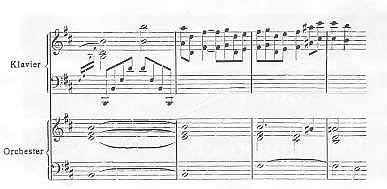
Secondly, 8 bars in 2/4 of a sprightly b major theme; I call it the secondary theme. At the end of this second fragment, there is an indication of an orchestral repetition in e major, i.e. a fourth higher:

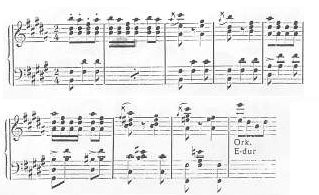
The third fragment is more important: about 140 bars of a scherzo-like 6/8. The first bars states a typical orchestral theme in b minor with the augmented fourth (E sharp); this theme is close to the famous Hall of the Mountain-King from Peer Gynt:


To pay a tribute to those surnatural beings that Grieg often depicted in his work, I will call it the "Troll theme".
The basses introduce a fourth theme, punctuated by the afterbeat chords of the "right hand" (bars G9-G16). Beginning as a chromatic scale, he twists his way around the chord notes of b minor. I will call it the "chromatic theme".
The piano enters by giving a variant of the previous 8 bars (bars G17-G24): the chromatic theme appears in the higher register with a b minor accompaniment in the left hand.
 (clic on this icon to hear the whole of the remaining fragments; you will have to scroll down in order to follow the music until the end, and then to come back afterwards to read the comments in regard of each page of music)
(clic on this icon to hear the whole of the remaining fragments; you will have to scroll down in order to follow the music until the end, and then to come back afterwards to read the comments in regard of each page of music)
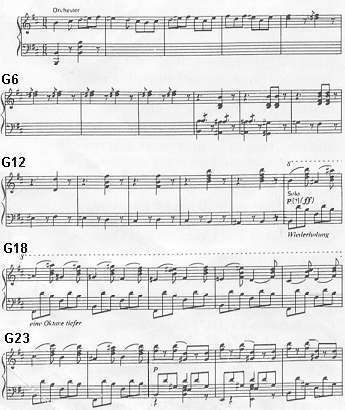
At G25 begins a harmonic progression on the following chords: E9, Am7, D9, Gm7 and C9, broken off by the horn's F sharp at bar G43. This characteristic use of the augmented fourth will appear further again. Bars G45-G48 echo in pp the 4 previous ones.
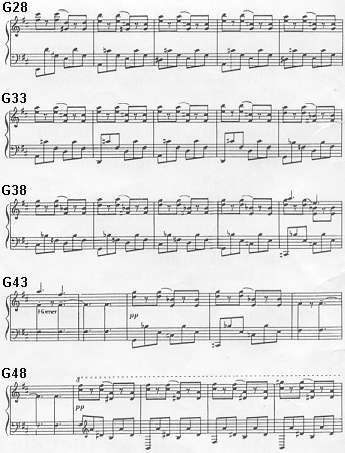
Bars G49-G72 forms the exact repetition of the 24 previous bars, but a fifth higher. The harmonic progression is thus: B9, Em7, A9, Dm7 and G9 broken off by the horn's C sharp (bars G67-G71); this being extended until G76.
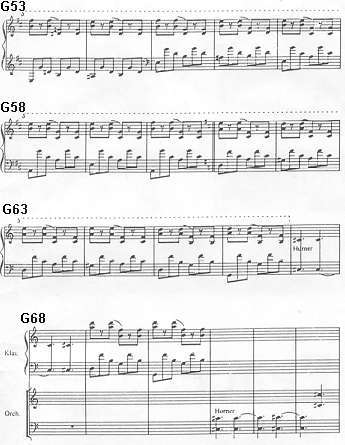
At G78, there is a question-marked E flat (perhaps a transcript mistake?). I think it must be rather a E sharp, that will make this bar closer to the opening troll theme.
The bars G79 to G85 look rather as a rough draft, as do the next 8 bars, a b minor pedal written on a single staff (G86-G93). At G94, the piano gives a new statement of the troll theme in a texture of alternated octaves. The structure is slightly different from the beginning of the fragment: in the fourth bar, the theme rests on a stressed doted minim.
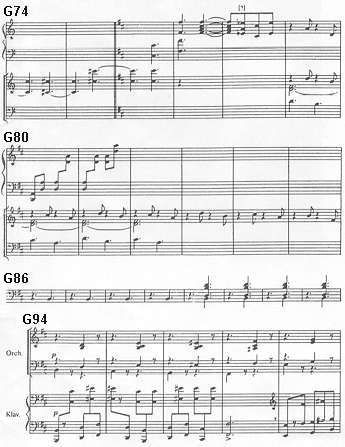
These four bars are repeated a fourth higher (e minor at bar G98) and further an octave higher (bar G102), but the fragment is broken off after the first bar. All following bar numbers are question-marked; the remaining music consists mainly of a long progression on a F sharp pedal.
Bars G111 to G114 state another variant of the troll theme, ponctuated by a chromatic progression from the woodwinds. These four "static" bars are answered by a chord progression; by enharmonic change, those chords are G7 - C#7 and C7 - F#7, another occurence of the augmented fourth! These 8 bars are repeated with the indication "the piano an octave lower".
At G119 a rythmic progression begins: the 8 previous bars are summed up to 4 (2 bars for the variant of the troll theme, and 2 for the "tritone" answer), whilst the piano is going down towards its lowest register.
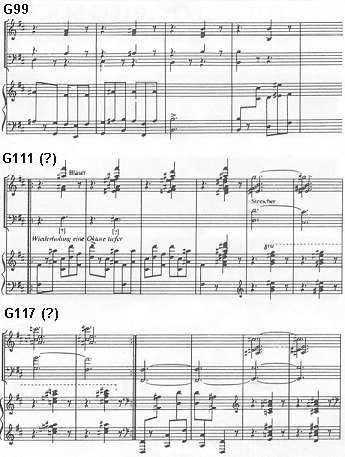
The 4 next bars (G123 to G126) are similar to the previous ones. At G127, the progression goes on on two bars, and finaly one, as the piano climbs back to the high. This ascension is broken off ff. (I think this last bar was intended to be repeated at least three times; this seems to me the logical continuation of the bars before, and it would fill the three following empty bars on the score.)
Lastly, the piano puts an end to this long F# pedal by a last stroke of alternated octaves (bars G135 to G138). Perhaps was this to introduce a ff return of the troll theme by the whole orchestra? Unfortunately, this is the place where the fragments end.
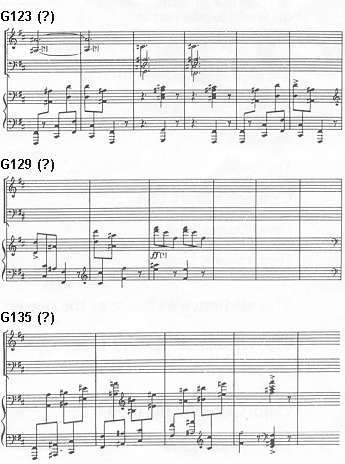
Read also the following article about Laurent Beeckmans' b minor concerto for piano and orchestra, made from those Grieg's fragments.